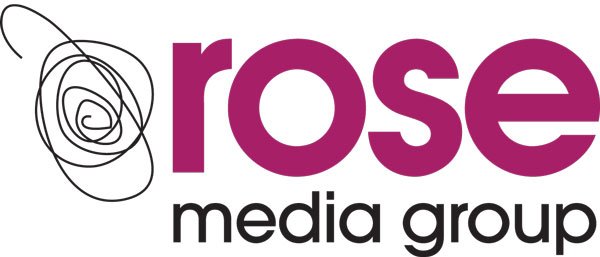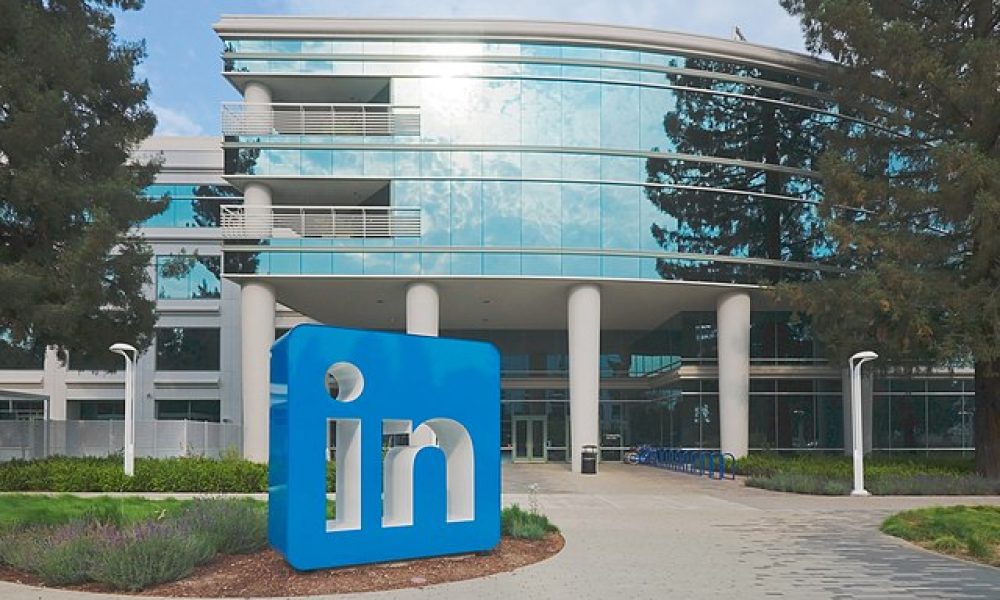Did you know LinkedIn is 277% more effective at generating leads than Facebook and Twitter? In this post, Becky, Digital Content Manager at Rose Media Group, will explore how LinkedIn can be used as an extension of your B2B sales team.
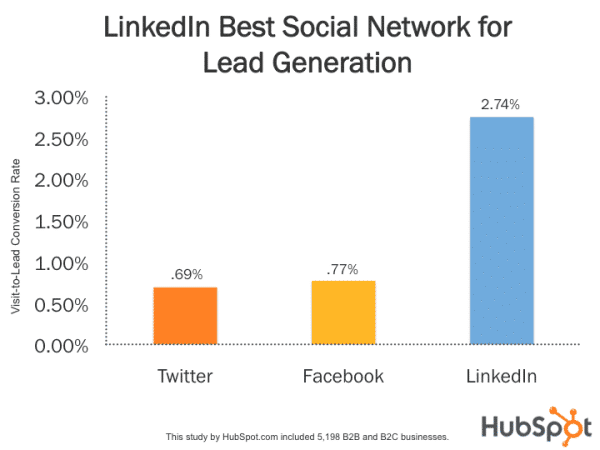
In recent years, LinkedIn has proved itself as a social media platform. It is no longer seen as a place to host your CV and hunt for a job. LinkedIn is a place to connect, share experiences and sell.
If your company is operating within the B2B space, your target audience is more than likely on LinkedIn. The platform has organic and paid-for tools that allow you to build a company profile, personal brand, community, and – perhaps most importantly to those reading – strong leads.
The great news is, using LinkedIn as an extension of your sales strategy is straightforward and effective. Use the following steps to strengthen your sales pipeline and build stronger connections with prospects.
Make use of your company page
The first step is to ensure that your company page is active. Being consistently active won’t necessarily boost your reach in the algorithm, but it will provide a steady stream of information for prospects looking into your company.
Ensure the content you’re posting is not primarily sales-based. This might seem backward if your aim is to drive leads – but no one likes to be flooded with sales messages.
We like to advise on the 40, 40, 20 rule – something we apply to campaigns for our clients, which goes as follows:
- 40% of content created for the audience, solving an issue or question
- 40% of content based around offer
- 20% of content should be creative
The odds are, your company is a thought leader in the industry already, but you’re not showcasing that knowledge online. Think of your company page like a shop window that leads to your website, in this analogy, the shop. Lead with insights and statistics that will get cogs turning and your audience’s interest peaked.
To build a profile worth reading, it’s time to take your product and highlight the “why”. Build the story around this with a sprinkle of company culture, success stories, and innovations in equal measure.
Pro tip: Don’t make the mistake of using a personal profile as a company page. LinkedIn has the option to make a company page that people can ‘follow’ rather than ‘connect’ with. Here you can showcase information about your company, link to your website, and post updates.
Encourage employees to build their network
People like to buy from people. We have seen B2C companies switch gears from being all about the brand to using influencers to reach and speak to their audience, and the same premise applies when it comes to B2B. Your employees are your advocates and their LinkedIn network is likely to be more engaged than the company page following.
Encourage your employees to build their network on LinkedIn and share their voice on industry topics. Some companies shy away from this for various reasons, but trusting your sales, marketing, and product development teams to tell your brand story is a smart move. It’ll not only outwardly display your company benefits but get your staff on board with the benefits of engaging in social media.
Often, LinkedIn is used as an address book when people are looking to connect with a professional that can meet a need. If your sales team’s profiles are optimised and active, they are creating a potential touchpoint.
Pro tip: If your team is worried about competition on the platform, encourage them to edit their privacy settings. You can set your profile so others can’t view your connections by navigating to your profile image > settings & privacy > visibility > who can see your connections > only you (see screenshot below).
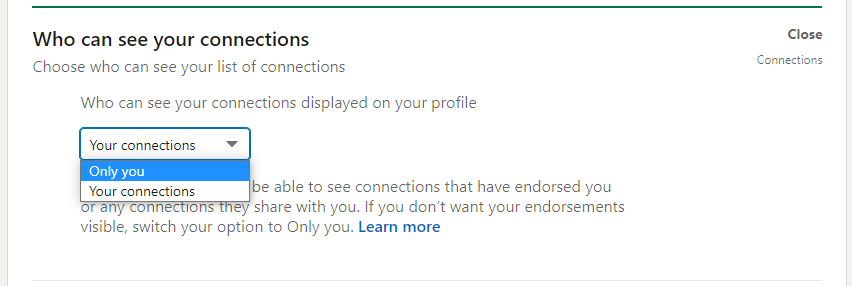
Engage more than you post
Treat LinkedIn like a business card – if you meet someone offline, connect with them online to keep the conversation going. The foundation of this social media platform is connections – if you’re linked to the right people, you’ll find more similar connections within their network.
Just like you might schedule time aside to reply to emails in your day, put time aside to engage with recent posts on LinkedIn. Liking, commenting, and sharing posts within and outside your network keeps you front of mind and active. It may even drum up common interest that helps you to get your foot in the door.
Showing your human side on the platform isn’t something that’s frowned upon – it is celebrated. Share behind the scenes of working from home, questions you have, or something on your mind.
Pro tip: Motivate your employees by helping them to update their profile, share some examples of posts you’ve made, or ping them groups that they might be interested in.
Make use of LinkedIn suggestions
As with other social platforms, LinkedIn updates you regularly to keep you on their site. Use these updates to your advantage in your sales pitches.
For example, a contact you worked with in the past may have moved to a new company. This could be an opportunity to reconnect, see how things are going and upsell.
Another example – a potential client has engaged with an existing client’s post. You could ask the existing client for a referral or to make an introduction with the cold contact when the time comes or gain insight into the projects they’re working on.
If you’re wondering how this might look, see the screenshot below. My colleague Kelly liked this post from our client at Zehnder. Due to the way LinkedIn’s timeline works, you’ll not only see posts from your connections on your timeline, but you’ll also find posts from connections activity (likes, comments, reactions etc) making you aware of what is going on outside of your network.
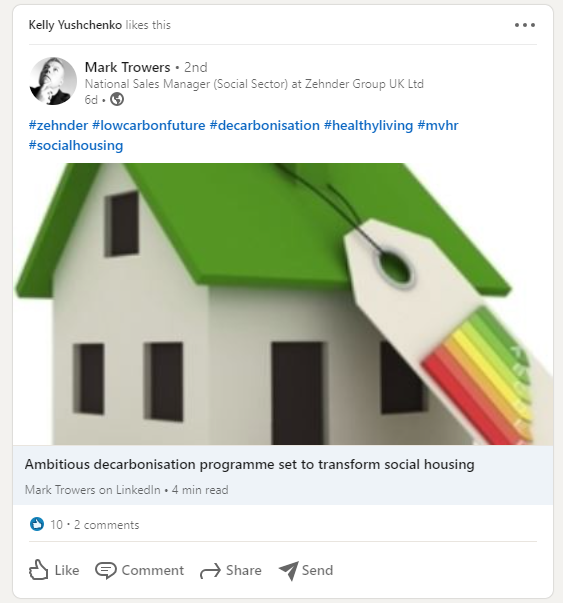
Make use of organic prospecting
Once you’ve become more active on LinkedIn, you’ll find connections start to be made and opportunities open up. Make use of organic prospecting by continuing to create a strong professional brand and be an active participant in your industry.
We recommend setting time aside each week, if not a small amount of time each day, to take action on the platform and stay up to date or inspire conversations. Actions can include:
- Asking questions to your connections
- Following business pages
- Joining LinkedIn groups and discussions
- Sharing industry news articles from publications or contacts
- Engaging with others content through likes and comments
- Posting your own insights from your everyday work
These days, sales is not about pushing product in every social media post. You should aim to show personality, become a thought leader and be part of your industry on LinkedIn. The saying “People buy from people” applies here – connections will be more likely to engage with you if you are acting human on the platform.
The great part about this is, it doesn’t take much additional effort! Sharing insights from your own day or writing a meaningful comment can take 5 minutes, but pay off a lot more in the long run.
Get to know how InMail works
Once organic prospecting is working in your favour, you might choose to boost your reach with some of LinkedIn’s paid advertising options. One of the most powerful and, in our opinion, most personable tools is InMail.
LinkedIn messages are free to send but have limitations; you can only send to your direct connections or potential connections in your network. InMail’s are similar to LinkedIn messages and appear in the same inbox, however, they are a paid-for tool that enables you to reach new contacts in your target audience. This is defined similarly to an advert by specifying age, location, job description and other demographic tags when setting up the campaign.
An InMail campaign goes directly to the recipient’s inbox, and – while it is tagged as sponsored – appears as any other message would.
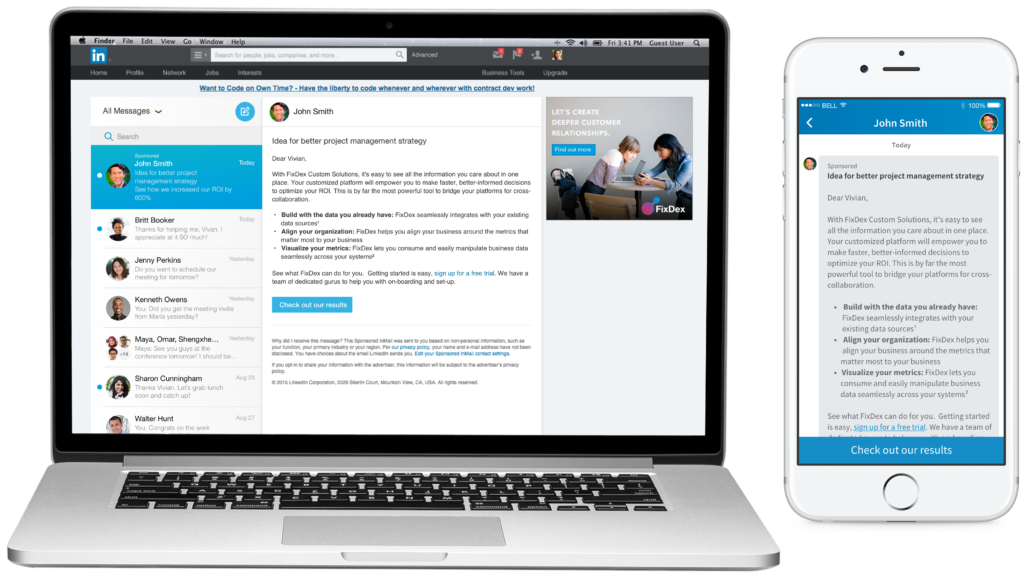
In short, you create the message and then use specific targeting to reach people you otherwise wouldn’t be able to connect with. You may choose to use an InMail campaign when launching training courses such as a new CPD, promoting an event, or a strong piece of content you’ve recently launched.
Often costing less than a colour separation – InMail’s are an effective way to spark a conversation and increase your reach for minimal spend.
For more advice on how to use social media tools, market your B2B business with flair and news from the Roses – make sure to follow us on LinkedIn!
